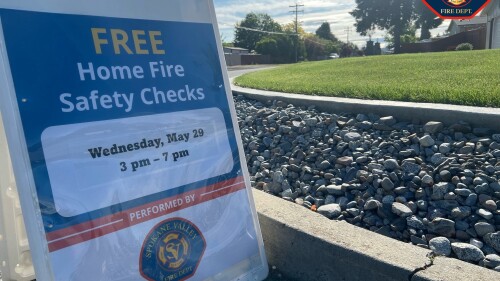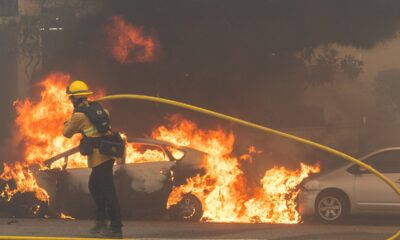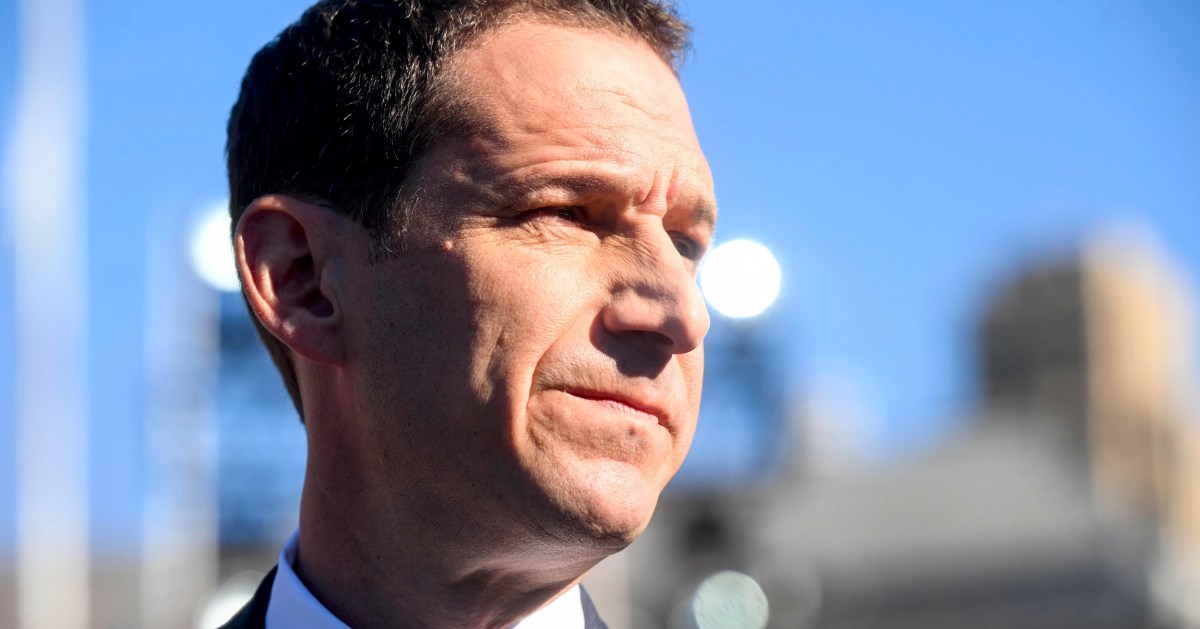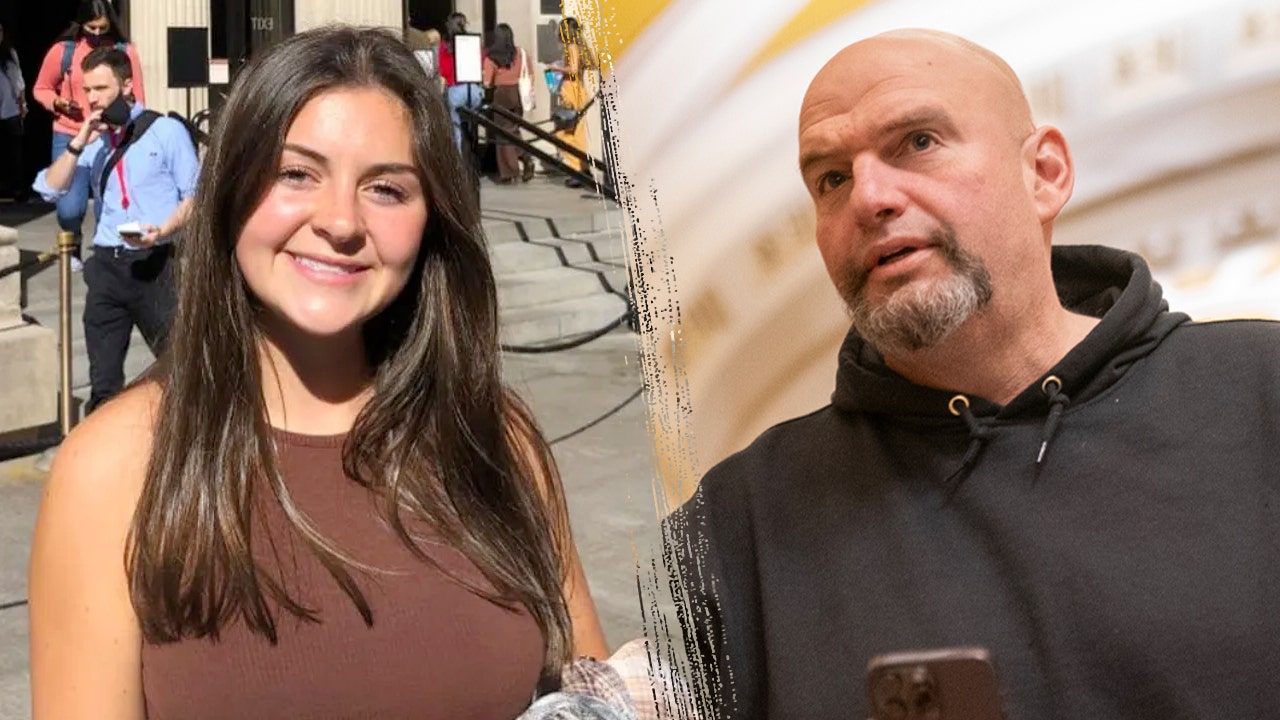Alaska
Alaska city begins demolishing abandoned houses

By Alex DeMarban
Anchorage Daily News
ANCHORAGE, Alaska — The city of Anchorage is tearing down abandoned houses that have become neighborhood eyesores and can attract criminal activity.
Officials with the first-ever program say it’s starting small, but they’re looking to expand it.
The goal is cleaning up neighborhoods and making lots available for new housing to alleviate the city’s severe housing crunch, they say.
The Development Services department, working with other city entities, plans to tear down 10 houses under the program, said Kenny Friendly, a spokesperson for Public Works.
The department is using $500,000 in pandemic funding from the 2021 American Rescue Plan, he said.
The property owners have agreed to the demolitions, he said. The removal of the run-down property benefits them, he said.
Go/no-go decisions are often the toughest for ICs managing expanding incident types
Four houses have already been removed, including two in Mountain View, and one each in Fairview and Abbott Loop.
The targeted houses are a stain on the neighborhood, residents say.
They also drain city resources, requiring constant attention through the year to keep them boarded up after people break-in, said Scott Campbell, chief inspector for Development Services. People sometimes move in illegally, litter the yard with waste, start fires or do drugs there, he said. The activity can lead to responses from police and fire departments.
“They’re a hazard,” he said.
The units to be torn down are just some of the 174 properties on the city’s vacant and abandoned building registry, which includes about 25 commercial properties, Friendly said.
Six houses remain to be torn down under the program — two in Spenard, two in Mountain View, one in the Abbott Loop area and one in the Huffman/O’Malley area.
Nearby residents have been ecstatic to see the houses removed, Friendly said.
Jorge Colocho lives in Mountain View near a crumbling house on Hoyt Street.
Built in 1950, the house looks like it was once well-groomed. But it’s now covered with plywood and overgrown with weeds. The roof is falling in, and the exterior walls are ripped open. Someone spray-painted “STAY OUT” across the front.
The abandoned house is a problem, attracting squatters and other criminal activity, Colocho said Thursday.

Chief Michael O’Brian describes the biggest risk management issues facing the fire service – and where progress can be made
On nearby Lane Street, the charred remains of an abandoned house have already been demolished under the program.
Last spring, a man pointed a gun at other people in the house and barricaded himself inside to evade police, city officials said. He also started a fire, engulfing the house in flames before police arrested him, they said. Fire crews responded and neighbors evacuated their houses.
Krista Chapman, a nearby resident, walked past the empty lot Thursday.
She’s glad the house is gone, she said.
“It was an eyesore,” she said. “A lot of people threw trash there.”
A boarded-up turquoise house in Fairview was recently demolished as part of the program, along Ingra Street near 13th Avenue.
Anchorage Assembly member George Martinez was there.
The house had been abandoned for years, he said. The yard was piled high with debris like old appliances, furniture, car and bike parts. Two junk cars also occupied the lot.
“The house was ripped and shredded internally, the structure was on a property with all sorts of trash,” Martinez said. “It was horrible, incredibly stinky, and the amount of rodents that ran out of the property was terrifying.”
There’s now an empty lot that could support multiple housing units, he said.
“The opportunity here is that we eliminate blight, reset a property and hopefully get it back on the market,” Martinez said.
The city is taking steps to ensure the program can continue, Martinez said.

Maximize CRR efforts by working with local agencies and tapping into federal resources
Mike Robbins, head of the Anchorage Community Development Authority, is applying for federal funds to do that. The entity would purchase vacant and abandoned properties and prepare them for redevelopment, he said.
James Thornton, president of the Fairview Community Council, said there are several abandoned and boarded-up properties in the neighborhood near downtown.
The Fairview council would like to see them gone, he said.
The dilapidated buildings hurt the quality of life and property values in the neighborhood, he said.
“When you see these abandoned, boarded-up houses, it makes the community feel like it’s not a good place to be, like it’s forgotten about and left behind,” he said. “And that’s not the way we feel about Fairview.”
Friendly said the demolitions can cost $20,000 to $50,000. The removal of hazardous materials can increase costs.
The property owners benefit, he said.
They often live out-of-state, but still pay taxes on the property.
The properties are listed on the city’s vacant and abandoned registry, which requires costly annual payments over time.
The demolition allows the property owners to “wash their hands of issues they deal with year after year,” he said.
They’re left with a cleared lot that they can sell, with utilities already in place for development, he said.
Some of the property owners under the program are selling their cleared lots to the city, he said.
“This is a huge win for the community, Public Works, the assembly and the administration as we take these steps to make Anchorage a better place,” Friendly said.
(c)2024 the Alaska Dispatch News (Anchorage, Alaska)
Visit the Alaska Dispatch News (Anchorage, Alaska) at www.adn.com
Distributed by Tribune Content Agency, LLC.

Gardner firefighters held training on water supply, relay pumping and attack hoselines

FDNY
A gas explosion in Brooklyn rattled an East Flatbush neighborhood and sent four people to the hospital

A Lexington lieutenant has been suspended and directed to take additional training after a disciplinary hearing

Alaska
Strong winds destroy deer shelter at Alaska Wildlife Conservation Center

ANCHORAGE, Alaska (KTUU) – Strong winds in the Portage area on Monday destroyed a shelter building at the Alaska Wildlife Conservation Center that was used to house Sitka deer. The conservation center says 80 mph winds swept through Portage Valley.
The conservation center says no animals were injured, but they are quickly raising money to rebuild. Their goal is $30,000, and as of Thursday morning, they have already fundraised over $26,000.
Sales & Marketing Director Nicole Geils said, “The shelter was in their habitat. It was essential for providing them a safe Haven during harsh weather. It’s a really useful area for when we’re feeding and doing enrichment with the deer and it’s also a safe space for recovery after medical procedures when needed.”
Executive Director Sarah Howard described how she learned about the damage.
“We had a staff member that radioed, ‘The shelter’s gone!’ And a couple of us were at least able to make a little light of the situation. Like, did it go to Oz? And thankfully, it didn’t go too far, and the deer were okay,” Howard said.
The conservation center is still accepting donations through their website.

See a spelling or grammar error? Report it to web@ktuu.com
Copyright 2025 KTUU. All rights reserved.
Alaska
After school funding dispute, 4 Alaska districts move on without federally promised money

Until last month, the U.S. Department of Education said Alaska underfunded four of its largest school districts by $17.5 million. As a result of a recent agreement, the schools in Anchorage, Fairbanks, Juneau and Kenai Peninsula Borough won’t directly receive any of that money.
However, two of the districts said they weren’t counting on receiving the money as they planned their current budgets, while the other districts either didn’t respond or declined to comment.
The $17.5 million is part of COVID-era pandemic funding, and until last month, how Alaska distributed that funding was at the heart of a years-long dispute between federal and state officials, and whether it was spent fairly.
The state repeatedly defended their school spending plan, while the federal government asserted the state failed to comply with guidelines and reduced spending on these districts with high-need or high-poverty areas, and withheld the sum they said was owed.
Federal officials said the state reduced spending to the Kenai Peninsula and Anchorage school districts by up to $11.89 million in the 2021 to 2022 school year, and all four districts by $5.56 million the following year.
Kenai Superintendent Clayton Holland said the district never budgeted for this particular federal COVID funding, as they were aware of the dispute.
“Had it gone through, we would have welcomed it, as we are facing a potential deficit of $17 million for next year” and have nearly exhausted the balance of funding the district can spend without restrictions, Holland said.
Anchorage School District officials did not respond to requests for comment.
The dispute came to an end on Dec. 20, when the federal department told the state it was releasing the funding, citing a review of the state’s one-time funding boosts in the last two budgets, and considered the matter closed.
Alaska Education Commissioner Deena Bishop led the state’s defense effort, including appealing the penalty, and applauded the move by the federal Department of Education. She said the state always followed the state law governing school funding.
“The department said, ‘We don’t agree with your formula, you should have given these guys more.’ And we said, ‘No, no, no. Only our Legislature can make the law about our formula. That’s why we stood behind it,” she said in an interview Tuesday.
The dispute centered around what was known as a “maintenance of equity” provision of a federal COVID aid law, which banned states from dropping per-pupil spending during the pandemic. Bishop said that decreases in funding in the four districts were due to drops in enrollment, according to the state’s spending formula.
Bishop defended the formula as equitable, noting that it factors in geographic area, local tax bases, and other issues. “I just felt strongly that there’s no way that they can say that we’re inequitable, because there are third-party assessments and research that has been done that Alaska actually has one of the most equitable formulas,” she said.
“Our funding formula is a state entity. Our districts are funded according to that,” Bishop said. “And so basically, they [U.S. Department of Education] argued that the distribution of funds from the state funding formula, the state’s own money, right, nothing to do with the Feds, was inequitable.
“So they picked these districts to say, ‘You need to give them more.’ And we’re saying, ‘No, you don’t have a right to say that. We spent your money, how you said, but only the state Legislature can say’” how to spend state money, she said.
She said the state felt confident about their spending plan for American Rescue Plan Act funding.
In addition to temporarily withholding the funding, the federal government further penalized Alaska by designating it a “high risk” grantee.
Federal and state officials went back and forth on compliance, with the state doubling down, defending their school spending. By May, the state had racked up another $1 million in frozen federal funds.
Bishop said despite the holds from the feds, they continued to award the funds to districts.
“We felt as though we would prevail. So we never wanted to harm school districts who were appropriated those funds the way that they were supposed to,” she said. School districts followed the dispute closely.
Juneau School District’ Superintendent Frank Hauser said the district did not expect or budget for the funds.
“JSD was slated only to receive approximately $90,000 of the “maintenance of equity” funds, much less than Kenai, Fairbanks, or Anchorage,” he said in an email. “JSD will not receive that money now; however, we had not anticipated receiving it and had not included it in our budget projection.”
The Fairbanks North Star Borough School District declined to comment on the issue. A spokesperson said the district administration is awaiting clarification from the state education department.
On Monday, the administration announced a recommended consolidation plan for five elementary schools to be closed, citing a $16 million deficit for next year. A final vote on whether to close the schools is set for early February.
Now the state is in the process of applying for reimbursements from the federal Department of Education, and expects to receive that full $17.5 million award, Bishop said. If districts have outstanding pandemic-related expenses, she said those can be submitted to the state, and will be reimbursed according to the state’s COVID-19 funding guidelines. “We’ll process that, and then we’ll go to the Feds and get that money back,” she said.
In December, Gov. Mike Dunleavy applauded the federal announcement, calling the dispute “a tremendous waste of time,” in a prepared statement. He repeated his support for President-elect Donald Trump’s calls to eliminate the U.S. Department of Education.
“On the bright side, this saga is a wonderful case study of the U.S. Department of Education’s abuse of power and serves as further evidence for why I support the concept of eliminating it,” he said.
Dunleavy linked to a social media post he made on X, which read, in part, that eliminating the department “would restore local control of education back to the states, reduce bureaucratic inefficiency and reduce cost. Long overdue.”
Sen. Löki Tobin, D-Anchorage and chair of the Senate Education Committee, pointed to the timing for the outgoing Biden administration and federal leaders’ desire to release funding to Alaska schools.
“It’s very clear that if the presidential election had ended in a different result, we would not be having this conversation,” she said. “Instead, they would be continuing to work with the department to find a more elegant, a more clean solution.”
She said the federal letter announcing the end to the long dispute doesn’t mean the issue of equity was resolved.
“I think their letter to the Department of Education and Early Development here in Alaska was very clear that Alaska never did fully comply with the guidelines, but instead, due to a want and a fervent hope that the resources would get into the schools and into the communities that so desperately needed them, that they would choose to not pursue further compliance measures,” she said.
Last year, the Legislature passed a budget with $11.89 million included for the state to comply with the federal requirements, but that funding was vetoed by Dunleavy, who defended the state’s position, saying the “need for funds is indeterminate.”
The budget did include a one-time funding boost to all districts, but Tobin said the annual school aid debate left districts in limbo for future budget planning.
“We can see how this has cost school districts, how it has created instability, how it has resulted in a system that is unpredictable for funding streams for our schools,” Tobin said.
Kenai Superintendent Holland expressed hope that school funding would be prioritized by elected officials this year.
“The bigger issue for us, and for all Alaskan school districts, is what our legislators and governor will decide regarding education funding in the upcoming legislative session,” Holland said.
Alaska
Alaska's population increases from 2023 to 2024

The increase is attributed to births outpacing both deaths and outward migration, according to new data from the Department of Labor and Workforce Development. Based on Census Data from 2020 and state data, the population is estimated to have increased to 741,147 people
-

 Business1 week ago
Business1 week agoThese are the top 7 issues facing the struggling restaurant industry in 2025
-

 Culture1 week ago
Culture1 week agoThe 25 worst losses in college football history, including Baylor’s 2024 entry at Colorado
-

 Sports1 week ago
Sports1 week agoThe top out-of-contract players available as free transfers: Kimmich, De Bruyne, Van Dijk…
-

 Politics1 week ago
Politics1 week agoNew Orleans attacker had 'remote detonator' for explosives in French Quarter, Biden says
-

 Politics7 days ago
Politics7 days agoCarter's judicial picks reshaped the federal bench across the country
-

 Politics5 days ago
Politics5 days agoWho Are the Recipients of the Presidential Medal of Freedom?
-

 Health4 days ago
Health4 days agoOzempic ‘microdosing’ is the new weight-loss trend: Should you try it?
-

 World1 week ago
World1 week agoIvory Coast says French troops to leave country after decades















